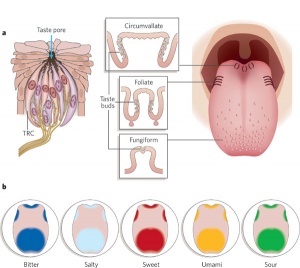Sensory - Taste Development
From Embryology
Introduction
These notes introduce the development of the sense of taste which can divided into five basic tastes: bitter, salty, sweet, umami (savoury) and sour. Current research appears to have displaced the historic concept of a tounge "map".
A study in rat suggests that neonatal changes in circumvallate papillae may result in postnatal changes in "taste". (More? Sbarbati A, etal, 2001) In frogs, a large taste disc (TD) is the largest vertebrate gustatory organ.
Postnatally, the sense of taste is also closely related to the sense of smell.
| Senses Links: Introduction | placode | Hearing and Balance hearing | balance | vision | smell | taste | touch | Stage 22 | Category:Sensory |
Glossary Links
- Glossary: A | B | C | D | E | F | G | H | I | J | K | L | M | N | O | P | Q | R | S | T | U | V | W | X | Y | Z | Numbers | Symbols | Term Link
Cite this page: Hill, M.A. (2024, April 28) Embryology Sensory - Taste Development. Retrieved from https://embryology.med.unsw.edu.au/embryology/index.php/Sensory_-_Taste_Development
- © Dr Mark Hill 2024, UNSW Embryology ISBN: 978 0 7334 2609 4 - UNSW CRICOS Provider Code No. 00098G
